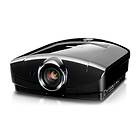Saxat ifrån
www.cine4home.de 3.3. Black level, contrast, brightness:
The Mitsubishi HC9000 is specified in the technical data with a luminosity of 1000-1100 lumens. As always, these values without regard to the color temperature of little relevance and are often abused by manufacturers misleading. The decisive factor is much more, how much brightness remains a net after color calibration. Trust is good, control is better and we were actually pleasantly surprised exception:
The maximum light output amounts to a serial port in the "Brightness" mode (ie without Cinema filter) to just under 1300 lumens, which is well above the factory specification! Here the manufacturer has ever been more conservative and has not thrown an inflationary fantasy values around. Also encouraging: The good optimization of the optical path to the standards to be deducted in the calibration lost very little: about 1100 lumens remain with correct colors to D65 color temperature. Thus, the HC9000 surpasses in terms of brightness, even the level of its main competitors X3 and Sony VW90.
Self-enabled Cinema filter of this generous light intensity lost little resources: 980 lumens maximum calibrated the HC9000 achieved with very bright colors, which can be useful for animation films and photographs. Through the Eco mode of all these values around 25% are deducted.
In the brightness of the projector convinced, but high light output are also difficult to combine with high contrast, such as the Mitsubishi HC9000 proposing here? In the technical specifications of Mitsubishi's full-bodied 150,000:1, conceals, however, that this value is only achieved with the help of the built-in optical dynamic iris.
Adaptive aperture systems are only as good as their general mechanics and image control. In the past, there were many examples of bad reactions (flickering, etc.) and a few really good systems, etc. by Mitsubishi. The HC7000 still in integrated real-time iris found in the HC9000 but unfortunately no reuse. Instead, it has a relatively sluggish iris built into the lens that does not allow real-time adjustment of the exposure. Accordingly, they limped in our tests the image behind it. If you measure it by the conventional method with the contrast (black screen / white screen), it closes slowly, until the actual value of the technical data is achieved (150,000:1). But a small light in the picture element is sufficient to leave the aperture opened. In other words: In the normal film frame the adaptive iris hardly acts and that's good because: She also provoked shading and can be heard clearly. Of the use of the adaptive iris is so discouraged and absolutely achieved with it "contrast measurement" for the picture quality and our other studies and reviews relevant.
Let us turn our attention to better the native contrast, ie the ratio of maximum white to black level, which allow the panel used and the optical path. As always, we have not only a (possibly good especially?) Limited test sample for determining the contrast values, as measured by the most conventional test magazines, but multiple serial devices, and then formed the middle: on average reached the HC9000 a contrast ratio of 25,000:1 maximum calibrated remain approximately 19,000:1.
This native contrast ratio should be evaluated with excellent and is currently second only to the great models of the JVC X-Series yet. Interesting is the fact that Mitsubishi has managed to tease out more contrast of the panel, as the manufacturers themselves SXRD: Sony. And there was another surprise:
Regular readers know that the selected zoom factor of the optics has a big influence on the relationship between contrast and brightness. The greater the zoom, the more brightness on the screen, but the less contrast and vice versa. Not so with the HC9000: Due to the extremely high quality coated optics influenced this contrast not so significant and the "Statement scattering" falls considerably more moderate.
The iris in the lens adjusts predominantly (adjustable in 16 steps), the amount of light that leaves the projector, and only secondarily the contrast. The HC9000 is now finally a projector, with which one can predict the actual brightness and contrast in your own home well, without having to calculate various computational examples have. You should close the iris but in no case more than half, otherwise they provoked considerable shading (see Section 3.10).
In terms of ANSI contrast to the elaborate lens also proved: the 420:1 mark was cracked here, which is the current LCOS reference. Owner of a home theater space optimized come in to enjoy a particularly high image depth in predominantly bright scenes, it is the DLP competition hot on his heels.
Practice
In the movie mode, the Mitsubishi HC9000 confident in almost every respect: it provides an excellent relationship between Black and appealing maximum brightness, which may be due to the optical aperture is optimally adapted to the screen size and the personal needs. Dark scenes are not brightened by a disturbing gray haze, daytime shots as believable light, as if they were actually incurred even under sunlight. But especially in mixed scenes with high contrast transitions within an image of the HC9000 confident with excellent plasticity that you find so rarely based in LCD / LCOS projectors. He is a prime example that the lens used for the contrast is at least as important as the panel and the light path.
 http://www.mitsubish...atures.html#top
http://www.mitsubish...atures.html#top

 Sökningen pågår
Sökningen pågår
 Avancerad sökning
Avancerad sökning


 3
3 
 Kan jag få provtitta din projektor..? =)
Kan jag få provtitta din projektor..? =) 

 Minhembio - Senaste nyheterna
Minhembio - Senaste nyheterna





 Fler
Fler
 Vilka bilder visas här?
Vilka bilder visas här?
